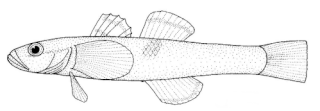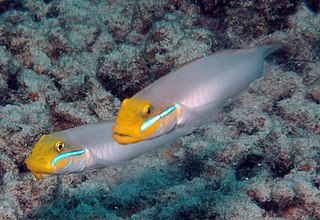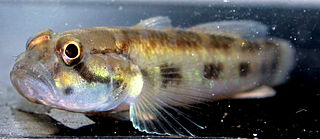
Graham's gudgeon, Grahamichthys radiata, is a species of goby of the family Thalasseleotrididae, the only member of the genus Grahamichthys. This species is found in rock pools and in the neritic zone, to 50 metres (160 ft) in depth, where sand or mud is lies around and partially buries rocks, shells, or other objects. It is unusual for a goby, in that it lives in loose schools.

The blacktailed spurdog is a dogfish, a member of the family Squalidae, found around New Caledonia in the central Pacific Ocean, at depths from 320 to 320 m. Its length is up to 75 cm.

Vieja melanurus, the quetzal cichlid, redhead cichlid or firehead cichlid, is a species of cichlid that is native to the Lake Petén system, the Grijalva–Usumacinta River basin and other Atlantic river drainages in southern Mexico, Belize and Guatemala, with introduced populations in a few other countries. It typically inhabits slow-moving or standing waters such as rivers, lakes and lagoons; although primarily a freshwater fish, it may occur in slightly brackish habitats. It is popular in the aquarium trade, where often listed under the synonym V. synspila/synspilum. It is almost entirely herbivorous, but may also take small animal prey.

Tripterygion is a genus of fish in the family Tripterygiidae, the threefin blennies, the species of which are found in the north eastern Atlantic Ocean, the Mediterranean Sea and the Black Sea.

Neogobius is a genus of goby native to Black Sea and the Caspian Sea basins. It is part of the broader Benthophilinae subfamily which is also endemic to the same region. Nevertheless, two Neogobius species have recently turned out to be highly invasive and spread across Europe and even to the Great Lakes of North America.

Valenciennea strigata is a species of fish in the family Gobiidae, the gobies. Its common names include the blueband goby, golden-head sleeper goby, and pennant glider. It is native to the Indian Ocean and the western Pacific Ocean where it can be found in outer lagoons and the seaward side of reefs. It occurs in a variety of substrates, sand, rubble, hard, at depths of from 1 to 25 metres. It primarily inhabits burrows dug under rubble, using them as both a nesting site and a refuge from predators. Such burrows typically have two entrances; however, only one of them is open, as the other is covered by rubble, sand, and algae. It can also be found in the aquarium trade. This species can reach a length of 18 centimetres (7.1 in) TL. It is the type species of the genus Valenciennea.

Bryaninops is a tropical Indo-Pacific genus of gobies. The genus takes its common name from the fact that it is commensal on gorgonians and black coral. The genus is further characterised by cryptic colouration.

The Gobionellinae are a subfamily of fish which was formerly classified in the family Gobiidae, the gobies, but the 5th Edition of Fishes of the World classifies the subfamily as part of the family Oxudercidae. Members of Gobionellinae mostly inhabit estuarine and freshwater habitats; the main exception is the genus Gnatholepis, which live with corals in marine environments. The subfamily is distributed in tropical and temperate regions around the world with the exception of the northeastern Atlantic Ocean, the Mediterranean Sea, and the Ponto-Caspian region. It includes around 370 species and 55 genera: Wikipedia articles about genera list about 389 species.
Chriolepis is a genus of gobies native to the Atlantic and Pacific coasts of the Americas.

Drombus is a genus of gobies native to fresh, brackish and marine waters of the Indian Ocean and the western Pacific Ocean.
Eugnathogobius is a genus of gobies native to fresh, brackish and marine waters of the Indian Ocean and the western Pacific Ocean region.

Grallenia is a genus of fish in the family Gobiidae native to the western Pacific Ocean.

Hemigobius is a genus of gobies native to the western Pacific Ocean.

Speleogobius is a genus of goby native to the Mediterranean Sea.

Acentrogobius viridipunctatus, or the Spotted green goby, is a species of goby found in brackish and salt water in the lower Chao Phraya River. It is the type species of the genus Acentrogobius.

Hemigobius hoevenii, commonly known as the banded mulletgoby, is a species of goby which occurs in the western Indo-Pacific region from Thailand to New Guinea and northern Australia where it is found in mangroves. The specific name most likely honours the Dutch ichthyologist Jan van der Hoeven (1801-1868) who has been honoured by Pieter Bleeker in a number of names for taxa.

Goby is a common name for many species of small to medium sized ray-finned fish, normally with large heads and tapered bodies, which are found in marine, brackish and freshwater environments. Traditionally most of the species called gobies have been classified in the order Perciformes as the suborder Gobioidei but in the 5th Edition of Fishes of the World this suborder is elevated to an order Gobiiformes within the clade Percomorpha. Not all the species in the Gobiiformes are referred to as gobies and the "true gobies" are placed in the family Gobiidae, while other species referred to as gobies have been placed in the Oxudercidae. Goby is also used to describe some species which are not classified within the order Gobiiformes, such as the engineer goby or convict blenny Pholidichthys leucotaenia. The word goby derives from the Latin gobius meaning "gudgeon", and some species of goby, especially the sleeper gobies in the family Eleotridae and some of the dartfishes are called "gudgeons", especially in Australia.
Pinnichthys is a genus of ray-finned fish from the family Gobiidae. They are found in the western Atlantic and the eastern Pacific, the genus was named in 2016. Three species previously classified in the genus Chriolepis have been included in Pinnichthys.
The Red Sea goby is a species of true goby from the family Gobiidae. It was once a species confined to the Red Sea but it has colonised the Suez Canal and the south-eastern Mediterranean by Lessepsian migration.

Bryconops melanurus, sometimes called the tail-light tetra, is a small species of freshwater fish from South America that primarily preys on insects. It lives in small schools and is an active swimmer, which means that it requires open space in its habitat. Nonetheless, it does not demonstrate a strong preference for any one biotope within its native range.















